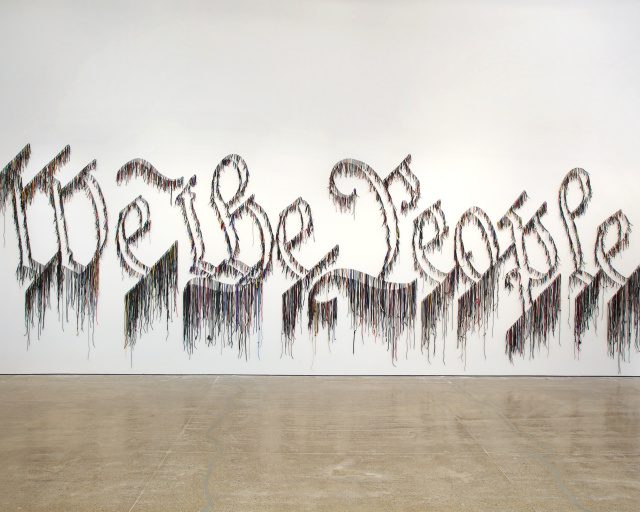Contemporary Arts Museum Housten, Housten, United States
16 Aug 2019 - 30 Nov 2019

Cover Image: Nari Ward, We the People, 2011. Shoelaces, 96 × 324 in (243.8 × 823 cm). Speed Art Museum, Gift of Speed Contemporary. Courtesy the artist and Lehmann Maupin, New York, Hong Kong, and Seoul
Contemporary Arts Museum Houston (CAMH) presents Nari Ward: We the People, the first museum survey in Texas of the work of artist Nari Ward (b. 1963, St. Andrew, Jamaica).
Since the early 1990s, Ward has produced sculptures by accumulating staggering amounts of humble materials and repurposing them in surprising ways. His approach draws from a variety of art historical and folk traditions and reflects the textures of Harlem, where he has lived and worked for the past 25 years. Seeking out the personal and social narratives embedded in materials, he conceives of his sculptures as tools for articulating relationships between people. Over the past three decades, he has addressed topics such as historical memory, political and economic disenfranchisement, racism, and democracy in an effort to express both the tenuousness and the resilience of the artist’s Harlem community—a struggle that remains relatable in communities across the United States.
Ward first rose to prominence in the early 1990s after attending art school in New York, New York and participating in The Studio Museum in Harlem’s prestigious residency program. Upon completion of the program, Ward installed Amazing Grace (1993) in the deserted Harlem firehouse that is now his studio. In this installation, recreated at CAMH, viewers walk atop a pathway made of fire hoses nailed to the floor in a dimly lit space. The path is surrounded by rows of discarded baby strollers while “Amazing Grace,” sung by Mahalia Jackson, loops overhead. As with other early works, Ward created Amazing Grace from raw materials scavenged in his neighborhood. Accumulated and transformed, these materials evoke the physical and socioeconomic realities of Harlem in that time. More broadly, the work conveys a sense of presence and absence suggested through its patinas of use and abandonment and its engagement of spiritual content.
Ward’s burgeoning career as an artist also coincided with a proliferation of international group shows in the 1990s, many of which included his work. Owing to its explorations of historical patterns of migration and displacement—particularly those tied to chattel slavery—and the rhetorics of inclusion and exclusion that form this country’s foundation, Ward’s work was poised to address this global expansionism. With the increased policing of national borders today, Ward’s work gains further relevance.
Ward has long probed concepts of identity, displacement, and belonging through his sculpture. He moved to New York from Jamaica as a child, and his work frequently refers to the migratory and diasporic experiences so many United States citizens share. His participatory work Naturalization Drawing Table (2004) offers museum visitors an opportunity to experience a bureaucratic environment that mirrors the potentially intimidating process of applying for citizenship.
We the People (2011) is the namesake work of the exhibition. This familiar phrase is taken from the Preamble to the Constitution of the United States, which describes the core values the Constitution exists to achieve: effective and democratic governance, justice, freedom, and equality. Ward spells this phrase out in Old English lettering outlined with thousands of multicolored shoelaces. In doing so, he raises a fundamental question: Who is “we”? Multiple answers emerge: “we” may be people fractured by divisive partisan politics, but “we” are also resilient, creative, and democratically engaged. Ward’s work demonstrates how a gathering—whether of people or objects—can be a catalyst for transformation.